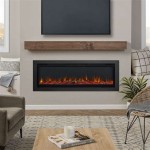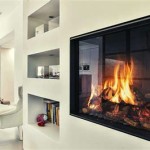Mounting a TV Above a Gas Fireplace: Safety Considerations and Best Practices
Mounting a television above a gas fireplace is a popular design choice, offering a visually appealing and space-saving solution for many homes. However, this installation presents several unique safety challenges that must be carefully addressed. The heat generated by a gas fireplace can damage the television's internal components, reduce its lifespan, and even pose a fire hazard if not properly mitigated. Before proceeding with such an installation, it's crucial to understand these potential risks and implement appropriate preventative measures.
This article aims to provide a comprehensive overview of the key safety considerations involved in mounting a TV above a gas fireplace. It will explore the potential hazards associated with heat exposure, discuss strategies for mitigating these risks, and outline best practices for ensuring a safe and reliable installation. A thorough understanding of these factors is essential for homeowners seeking to enhance their viewing experience without compromising safety.
Understanding the Risks: Heat and Its Impact on Televisions
The primary concern when mounting a television above a gas fireplace is the heat produced by the fireplace. Televisions are designed to operate within a specific temperature range, typically between 32°F (0°C) and 104°F (40°C). Exceeding this range can lead to a variety of problems, including:
- Component Damage: Excessive heat can damage sensitive electronic components within the television, such as capacitors, resistors, and integrated circuits. This can result in picture distortion, flickering, dimming, or complete failure of the TV.
- Reduced Lifespan: Even if immediate damage isn't apparent, prolonged exposure to heat can significantly shorten the lifespan of the television. The constant thermal stress can accelerate the degradation of components, leading to premature failure.
- Screen Damage: LCD and OLED screens are particularly vulnerable to heat. Excessive heat can cause discoloration, warping, or even cracking of the screen.
- Fire Hazard: In extreme cases, overheating components can pose a fire hazard. Although rare, the risk of a fire should not be dismissed, especially if the fireplace is used frequently or for extended periods.
The amount of heat that reaches the television will depend on several factors, including the size and BTU output of the fireplace, the distance between the fireplace and the television, the presence of a mantel or other heat-deflecting features, and the ventilation in the room.
It's important to note that even with a seemingly low-heat fireplace, prolonged exposure can still cause damage over time. Continuous operation of the fireplace during colder months can create a cumulative effect, gradually degrading the television's internal components.
Mitigating Heat Exposure: Strategies for a Safe Installation
To minimize the risk of heat damage, several strategies can be employed. These strategies focus on reducing the amount of heat that reaches the television and improving ventilation to dissipate any accumulated heat.
- Mantel Installation: A properly sized mantel is one of the most effective ways to deflect heat away from the television. The mantel acts as a barrier, preventing hot air from rising directly towards the TV. The larger the mantel, the more effective it will be at deflecting heat. Ideally, the mantel should extend at least 8-12 inches from the wall above the fireplace opening. The depth of the mantel is also important; a deeper mantel will provide better protection.
- Distance and Height: Increasing the distance between the fireplace and the television can significantly reduce heat exposure. Mount the television as high as possible above the fireplace, while still maintaining a comfortable viewing angle. A minimum distance of 12 inches between the top of the fireplace and the bottom of the television is generally recommended, but this may need to be increased depending on the fireplace's heat output.
- Heat Shielding: If a mantel is not feasible or sufficient, consider installing a heat shield. Heat shields are typically made of metal and are designed to deflect heat away from the television. They can be mounted above the fireplace or directly behind the television. It's crucial to choose a heat shield that is specifically designed for this purpose and is made of a heat-resistant material.
- Ventilation: Adequate ventilation is essential for dissipating heat. Ensure that there is sufficient airflow around the television to prevent heat from building up. Avoid enclosing the television in a tight space, as this will trap heat and exacerbate the problem. Consider using fans to circulate air and draw heat away from the TV. Small, quiet USB-powered fans can be strategically placed behind the television to improve airflow.
- Lower BTU Fireplace: If you are installing a new fireplace, consider choosing a model with a lower BTU (British Thermal Unit) output. A lower BTU rating indicates that the fireplace generates less heat, reducing the risk of damage to the television.
- Fireplace Usage: Be mindful of how often and for how long the fireplace is used. Limiting the duration of fireplace use can help to reduce the overall heat exposure to the television. Consider using the fireplace primarily for aesthetic purposes rather than as a primary heat source.
- Temperature Monitoring: Monitoring the temperature behind the television can provide valuable insights into the effectiveness of your heat mitigation strategies. Use a digital thermometer with a remote probe to measure the temperature behind the TV while the fireplace is in operation. If the temperature exceeds the television's recommended operating range, further adjustments may be necessary.
Implementing a combination of these strategies is often the most effective way to protect the television from heat damage. Carefully assess the specific characteristics of your fireplace and the layout of your room to determine the most appropriate measures.
Best Practices for Installation: Ensuring Stability and Safety
Beyond heat considerations, the physical installation of the television above the fireplace must be performed safely and securely. Improper installation can lead to the television falling, causing damage to the TV, the fireplace, and potentially injuring anyone in the vicinity.
- Wall Mount Selection: Choose a wall mount that is specifically designed for the size and weight of your television. Ensure that the mount is sturdy and capable of supporting the TV securely. Opt for a full-motion mount if you want the flexibility to adjust the viewing angle. Before purchasing, check the weight rating of the mount and compare it to the weight of your television. It's always best to choose a mount with a weight capacity that exceeds the TV's weight by a comfortable margin.
- Stud Finding: Locate the wall studs using a stud finder. The wall mount must be securely attached to the studs to provide adequate support. Avoid mounting the television solely to drywall, as drywall is not strong enough to support the weight of the TV. If studs are not ideally located, consider using a bridging solution that spans multiple studs to distribute the weight more evenly.
- Proper Anchoring: Use appropriate screws and anchors to attach the wall mount to the studs. Ensure that the screws are long enough to penetrate deeply into the studs. If using lag bolts, pre-drill pilot holes to prevent the wood from splitting. Follow the manufacturer's instructions for the wall mount carefully.
- Cable Management: Plan your cable management carefully to avoid unsightly wires and potential hazards. Use cable ties, cable sleeves, or cable raceways to organize and conceal the cables. Run the cables through the wall if possible, using a cable pass-through plate to protect the wires from damage. Ensure that the cables are not exposed to excessive heat from the fireplace.
- Professional Installation: If you are not comfortable performing the installation yourself, consider hiring a professional installer. A professional installer has the experience and expertise to ensure that the television is mounted safely and securely. They can also advise you on the best strategies for mitigating heat exposure.
- Fireplace Clearance: Ensure there is adequate clearance around the fireplace for proper ventilation and maintenance. Don't block any vents or openings on the fireplace with the television or its mounting hardware.
- Electrical Safety: Ensure that the electrical outlet used for the television is properly grounded and meets all local electrical codes. Avoid overloading the circuit, and use a surge protector to protect the television from power surges.
By adhering to these best practices, you can ensure that your television is mounted safely and securely above your gas fireplace, minimizing the risk of accidents and protecting your investment.
Installing a television above a gas fireplace presents both aesthetic and functional advantages, but it also introduces significant safety concerns. By understanding the risks associated with heat exposure, implementing appropriate mitigation strategies, and following best practices for installation, homeowners can create a safe and enjoyable viewing experience. Careful planning and attention to detail are essential for a successful and long-lasting installation.
The information provided in this article is intended for informational purposes only and should not be considered a substitute for professional advice. Always consult with qualified professionals before undertaking any electrical or structural work. Local building codes and regulations should also be consulted to ensure compliance with all applicable requirements. Prior adherence to manufacturer's instructions for both the fireplace and the television are indispensable.

Can I Mount My Tv Above The Fireplace

Can I Mount My Tv Above The Fireplace

Mounting A Tv Above Fireplace 5 Things To Consider

Mounting Tvs Above Gas Fireplaces Safe Or Not Just Log Fires

Mounting Your Tv Above Fireplace

ᑕ❶ᑐ What To Consider Before Mounting A Tv Above Fireplace

How To Safely Mount Your Tv Above The Fireplace

Mounting A Tv Over Fireplace How Does It Work Echogear

ᑕ❶ᑐ What To Consider Before Mounting A Tv Above Fireplace

Mounting Your Tv Above Fireplace
Related Posts








